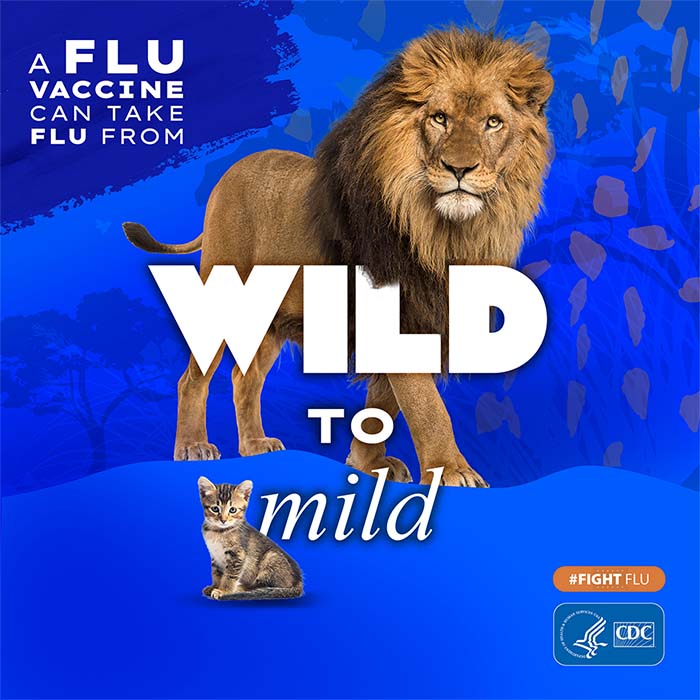Avian Influenza A (H7N2) in Cats in Animal Shelters in NY; One Human Infection
December 22, 2016 — An outbreak of avian lineage influenza A H7N2 (“H7N2”) virus infection among cats in an animal shelter in New York City was first reported on December 9, 2016. CDC has confirmed one associated human infection in a person who had close, prolonged unprotected exposure to the respiratory secretions of infected, sick cats at an affected New York City animal shelter. The person had relatively mild illness and is recovering. No person-to-person spread of this virus has been identified at this time. CDC believes the risk to the public’s health from this virus is low, but CDC and state and local public health authorities are conducting a routine investigation to try to identify any other human infections associated with exposure to ill cats and ensure that there is no person-to-person spread of this virus occurring.
Avian influenza viruses have rarely been reported in cats, but it is possible for cats to be infected with influenza, including avian influenza viruses. This is the third human infection with avian influenza A H7N2 ever reported in the United States. Previously there have been two human infections with similar H7N2 occurring in 2002 (VA) and 2003 (NY) [185 KB, 4 pages]. One of these infections was associated with exposure to infected poultry. The source of infection in the second person could not be determined. Both people who became ill as a result of H7N2 virus infection recovered completely. Other human infections with avian influenza viruses have resulted mostly from prolonged close contact with infected birds.
Finding an avian influenza virus in an unexpected host (like a domestic cat) is always concerning and any human infection with a non-human influenza virus is concerning as well. These incidents must be carefully investigated and appropriate actions taken to ensure that there is no ongoing spread of this H7N2 virus among people.
Animal and public health experts are working together to learn more about this situation and the characteristics of this virus. More than 350 people with exposure to infected cats during this outbreak have been screened or tested for infection with H7N2. The ill person reported by New York City Department of Health and Mental Hygiene (NYC DOHMH) is the only human infection that has been detected. This, combined with past experience with rare avian influenza infections in humans via birds, suggest that the risk of human infection is low, but likely increases with duration and intensity of exposure. It is possible that additional human infections could be detected in association with this outbreak in cats. The risk of human infection from contact with an H7N2-infected person also is thought to be low. The risk posed by this virus to the public (people who have no contact with infected cats or an infected person) is thought to be very low at this time.
CDC is in close communication with human and animal health partners regarding this situation, providing situation-specific guidance related to testing, clinical management, antiviral treatment and chemoprophylaxis, and infection control to support the on-the-ground response, which is being led by public health and animal health experts in New York City. The investigation revealed that the person infected with H7N2 traveled on a domestic flight while potentially infectious. CDC is beginning a contact investigation to notify the passengers seated near this traveler who may have been exposed to the disease. CDC has disease-specific instructions (protocols) to identify passengers who may have been exposed during a flight. This investigation will focus on the persons sitting near the ill traveler. State and local health department officials will reach out to the traveler contact(s) in their jurisdictions and provide recommendations and instructions for laboratory testing or clinical follow-up when needed.
CDC has long-standing guidance for cat owners, including that people wash their hands with soap and running water after contact with cats, cat saliva or stool, and after cleaning a litter box. In the context of the current outbreak in New York, people who have adopted cats from affected shelters and whose cats are showing signs of respiratory illness should minimize close contact with their pet during its illness and manage their cats illness at home in consultation with a private veterinarian as recommended by NYC DOHMH. More guidance for pet owners from NYC DOHMH is available. Recommended precautions are even more important for people who are at high risk of serious flu complications, such as those who are being treated for cancer, or who have other chronic health conditions such as diabetes, heart disease, liver disease or kidney disease or women who are pregnant. Any influenza infection can be more serious in these people.
CDC also has examined the genetic sequence of the virus isolated from an infected cat in an animal shelter to see if there are genetic changes known to be associated with improved ability to infect and cause illness in mammals. (Subtyping was performed by the Wisconsin Veterinary Diagnostic Laboratory and the U.S. Department of Agriculture’s National Veterinary Services Laboratories (NVSL) provided CDC with the sequencing information.) CDC will begin additional laboratory work with the specimen submitted by New York, including isolating the virus to try to grow it and then conduct further testing to look at the ability of this particular virus to infect and cause disease in animal models. Also, CDC will conduct testing to see whether an existing H7N2 candidate vaccine virus from 2002 could protect people against the 2016 H7N2 virus. CDC routinely develops influenza candidate vaccine viruses when novel influenza viruses are found in people and this was done with the virus isolated from the human infection in 2002.
The New York City Department of Health and Mental Hygiene (DOHMH) issued press releases on December 12 and December 22, 2016.
DOHMH issued a veterinary advisory [382 KB, 3 Pages] on December 16, 2016
More information about avian influenza in cats is available.
